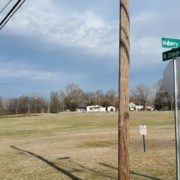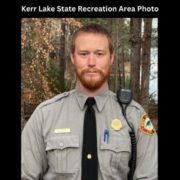TownTalk: Update On ARPA Funds
/by Bill HarrisThe American Rescue Plan is infusing money – lots of money – into communities across the nation, one of the federal government’s responses to the COVID-19 pandemic and the waves of economic havoc it has created over the past several years.
Marley Spencer, a regional project manager who works with Kerr-Tar COG, is someone who can help figure out how to best use the money allocated to various municipalities across the five-county region.
According to Spencer, Vance County is getting roughly $8.5 million in ARPA money; Granville County is set to receive $11.7 million and Franklin County is getting about $13.5 million of the $1.9 trillion – with a T – in ARPA funds.
She discussed with John C. Rose on Wednesday’s TownTalk some of the short-range and long-range planning that is involved in putting the money to use.
Spencer lends her expertise and training to help local governments to assess their needs, identify assets and infrastructure and then help them execute their plans for the ARPA funds, helping them “connect the dots and stretch those resources,” Spencer said.
The four main categories that municipalities can choose from are revenue replacement, negative COVID impact, premium pay for essential workers and infrastructure project – defined as water and sewer and broadband.
With those categories in mind, she said, municipalities have until December 2024 to designate where they want their share of ARPA funds to go; they have two years to spend the money – it all has to be spent by December 2026.
Simply put, ARPA funds can help municipalities “free up funds that they can use on other things to enhance the community,” Spencer explained.
Down the road, money from the ARPA-funded Rural Transformation Grant also will be available to “enhance communities, revitalize downtowns and strengthen neighborhoods.”
CLICK PLAY!
County Commissioners May Decide To Sell City Its Share Of 114 Vacant Properties For City To Redevelop
/by WIZS StaffThe city’s land planning committee and the county’s properties committee held a meeting Thursday afternoon to discuss the disposition of 114 jointly owned properties within the city limits.
The group decided to allow the plan to sell the land to the city to move forward, and that is the recommendation that will go before the full board of county commissioners at its Jan. 9 meeting.
If the board approves the recommendation, the city would buy out the county’s interest in the properties – all are vacant tracts and all are tax foreclosures dating back to 2007, said County Manager Jordan McMillen. The city has a 43 percent interest in the properties and the county holds a 57 percent interest.
The meeting lasted about 90 minutes, with both groups asking questions and sharing opinions about possible future redevelopment of the properties, which McMillen said totals about 26 acres when added all together.
“If it all went back on the tax books today,” McMillen told WIZS News after the meeting’s conclusion, it would add about $4,800 tax dollars to the city and county coffers.
County commissioners Dan Brummitt, Yolanda Feimster, Leo Kelly and Archie Taylor were present for the joint meeting representing the county’s properties committee; Melissa Elliott and Jason Spriggs represented the city of Henderson’s land planning committee.
“I don’t mind transparency or accountability because I feel confident with what I’m doing,” said
Henderson City Manager Terrell Blackmon, who explained the general plan to the group.
Blackmon said the city is ready to ramp up the redevelopment efforts as other projects to piggyback on progress being made with the West End Urban Redevelopment Area and a similar effort getting underway in the Flint Hill community.
In outlining the overall efforts taking shape within the city, he said there are developers knocking on the door to begin projects. When planning for the West End URA, the UNC School of Government reported that the city was 3,000 housing units short of where it needed to be. The city needs housing that is diverse, safe and affordable, Blackmon said. And as the city ramped up code enforcements over the past few years, the result was more torn down houses than houses that were preserved.
By all accounts, both groups supported the idea of having the city move forward with purchase of the properties, but Commissioner Brummitt said it’s time to “pick a project and move – make it happen.”
In comments to the joint group, Brummitt and Taylor both expressed concern that there has been much talk over the years about redevelopment, but little action.
We “continue to talk and talk about it, but we’re not taking any steps,” Brummitt said.
“We have developers on deck that are ready to move,” said Council member Elliott.
Blackmon said the redevelopment would most certainly need to be a mixture of single-family and multi-family structures, as well as a combination of renters and homeowners.
In response to some discussion about neighborhood safety, Brummitt said home ownership would be beneficial. “If you own that property, you’re more committed to it,” he said. Blackmon also commented that home ownership is one way to stabilize neighborhoods.
Elliott said a key component to the redevelopment efforts is educating the community about home ownership.
“If you can pay $1,200 to rent a house, you can pay $1,200 to buy a house,” she said, noting numerous programs available for first-time homebuyers.
Blackmon reminded the group that municipalities don’t build homes, but they can help plan for the types of housing that get built.
“When the municipality owns the dirt, we have some flexibility” in the type of housing we’d like to see in the community.
He used the term “workforce housing” to describe affordable housing options, including those for city employees and others who may choose to live in the same community where they work.
Whether it’s single-family or multi-family housing, the city must be aware of what the community can afford to spend. And developers that build in existing neighborhoods have the opportunity to improve the quality of life for residents who already live there – or who may choose to move there.
CLICK PLAY!
TownTalk: James Turner, NC Governor
/by Laura GabelBack in his day, James Turner may have been considered a “typical” farmer in the area – by today’s standards, however, it depends on how you define “typical.”
Turner owned productive farmland, but he also was a legislator, a U.S. senator and served three one-year terms as the governor of North Carolina.
The plantation home known as Oakland, situated near Williamsboro, burned down in 1935, but his other home, Bloomsbury, still stands in Warren County in the general vicinity of Ridgeway and Manson.
Turner was born in 1776 and died in 1824, and he and some of his contemporaries were the topic of the tri-weekly history segment of TownTalk with Bill Harris and Mark Pace.
Pace, a local historian North Carolina Room specialist at Oxford’s Richard Thornton Library, said Turner was referred to as “Lordly Governor Turner,” in his day. He was among a handful of prominent Warren County-area individuals that some have called the “Warren Junta.”
The term “junta” refers to a small group wielding great power in a country, usually following a revolution.
“Between 1790 and 1840, Warren County was the place to be,” Pace said, adding that during that time, three of the state’s five governors hailed from Warren County.
One governor, Nathaniel Macon, went from governorship to become the Speaker of the U.S. House.
In 1802, Turner was chosen by the state legislature to be the 12th governor of the state following the death of John B. Ashe, who died after being elected governor but before he could be sworn in to office.
He then served three one-year terms and then represented North Carolina in the U.S. Senate.
Turner was among a group of relatively conservative politicians at the time who advocated minimal responsibilities by the federal government – basically, they just wanted a federal postal service, Pace said.
There is some uncertainty about where Turner is buried, but Pace said he is fairly confident that Turner’s final resting place is at Bloomsbury.
One of Turner’s sons, Daniel Turner, also figured prominently in the politics of his day. The younger Turner, a West Point graduate, also served in the state legislature and in the U.S. Congress, Pace said. But he never really was able to capitalize on the opportunities afforded him.
He came home to Warren County and studied to become an attorney, Pace said. He was elected to the state house, and then made a successful bid for the U.S. Congress, where he served a couple of terms.
Pace said Turner opened an academy in Warren County. His wife, Anna, “ran things and kept things going,” Pace said. The academy brought in teachers from up North and was going along pretty well until it ran into financial trouble.
“His friends got together, pulled some strings,” Pace said, and Turner ended up accepting an appointment to be the director of the Naval shipyard in San Francisco Bay. He and his wife both are buried there.
Turner’s wife, Anna, married into a fairly prominent family, but her lineage was nothing to sneeze at. Her maiden name was Key – and her father, Francis Scott Key, was an attorney in his own right who perhaps is best known as the person who wrote what was to become this country’s National Anthem.
CLICK PLAY!
TownTalk: Signs of Positive Growth
/by Laura GabelKing’s Daughters Park is not the largest park in the area, and it doesn’t have all the amenities as other recreation areas, but what it does have is what is known in the real estate world as a critical asset: Location, location, location.
City officials are looking at ways to increase the park’s boundaries as plans continue to progress for the West End Urban Redevelopment Area (URA).
The Henderson City Council approved a recommendation from city staff to acquire three vacant properties near the park that, if successful, would add to the overall footprint of the park, located on Montgomery Street. Having access to green space promotes public health while preserving the characteristics of the park.
“We’ve got some negotiating to do,” City Manager Terrell Blackmon told WIZS News Tuesday. But the council gave staff permission to move forward to try to buy the vacant properties and refurbish the park as part of the overall redevelopment plan, Blackmon explained.
One of the three property owners has been contacted, but Blackmon said the city is still in the process of contacting the other two.
As plans for the West End URA continue to take shape, the idea is to bring a mixture of rental homes and private residences to the area, while developing business and recreation opportunities within walking distance of where people live.
The URA and other opportunities for redevelopment are part of the city’s overall strategic plan, as well as employee retention.
Blackmon said succession planning plays a role in recruiting and retaining city employees, and it’s one of the points contained in the strategic plan.
The city also approved a new entry-level planning technician position in the development services division, made necessary when the current zoning administrator was promoted to the vacant position of community development manager.
CLICK PLAY!
TownTalk: Police Chief Barrow Talks Shop With A Cop
/by Laura GabelIt may have been cold – it IS December, after all, but there’s a pretty good chance that area law enforcement officers and 47 youngsters in the community felt nice and warm on the inside during the annual “Shop with a Cop” event this week.
Henderson Police Chief Marcus Barrow said individuals representing the police department, sheriff’s office, fire department, highway patrol, animal control and park rangers got to shop with children at Walmart in Henderson.
“We got to see some kids that we interacted with throughout the year,” Barrow said on Thursday’s TownTalk. One child had a special request to shop with an officer who was working a shift, but Barrow said they were able to make some adjustments in the schedule to grant the child’s request.
“He was able to shop with that kid – it was heartwarming,” Barrow said.
In all, the bill came to about $8,000, and that’s after Walmart generously knocked a little bit off the final tally, Barrow said.
In years past, law enforcement agencies have worked in partnership with the local Chamber of Commerce to raise money for the spending spree, but it just didn’t happen this year. Chalk it up to the residual pandemic restrictions and the strain on law enforcement agencies to provide adequate staffing.
“We look forward to partnering with them next year,” Barrow said.
In the meantime, it was important to keep the event alive, so that’s what they did.
It’s a time to let children be children and roam up and down the toy aisles. But it was sobering for Barrow to see some of the older kids get everyday items like hygiene products.
“We want them to think of themselves,” Barrow said. The adults usually steer the kids to clothing items, including coats, during the shopping spree.
But many of the children also wanted to pick out gifts for their parents or other family members, too.
Sometimes, the gift is in the giving, not in the receiving.
CLICK PLAY!
TownTalk: Protecting Animals In Bitter Cold
/by WIZS StaffWhether you’re keeping up with weather forecasts as you stay warm indoors or whether you have to be out in the elements, here’s the main takeaway: it’s going to be bone-chilling cold for the next few days.
And while we humans can add an extra layer of clothing or stay bundled up by the fire if we’re lucky, Animal Services Chief Frankie Nobles reminds pet owners to be mindful of the needs of our furry friends, too.
If you have a pet outside, bring it inside the house or into a garage – anything you can do to block the wind, Nobles told John C. Rose on Thursday’s TownTalk.
“When that wind gets to blowing, it gets colder and colder” for pets who must remain outside. If possible, move doghouses to a more sheltered spot in the yard or throw an extra blanket on top of the doghouse for an extra layer of protection, leaving just enough of an opening for the dog to get in and out.
Use wood shavings inside dog houses instead of blankets, which can get wet and make matters worse.
If you use heat lamps, make sure they’re not too close to things that can catch fire, he warned.
In addition to these measures, it’s equally important to make sure outside animals have access to fresh water.
“Water’s gonna freeze, that’s a guarantee,” Nobles said. Clearing out water bowls is essential when temps dip below freezing.
And they need to have plenty of food, too. “Feed helps produce energy, which produces heat,”
He said. This goes for outside pets and livestock, too.
Some horse owners put blankets on their horses, which helps them stay warm. Horses can be seen in pastures wearing blankets, Nobles said, “but you’ll also see a bunch of hay. Their body has to break that hay down (and) that’s what keeps them warm,” he said.
CLICK PLAY!
TownTalk: St. Paul’s Lutheran Plans Food Ministry
/by Laura Gabel
St. Paul’s Lutheran Church in Ridgeway is launching a food ministry to try to help residents in Vance and Warren counties who find themselves struggling with having enough food for themselves and their families.
The food ministry, modeled after the story in the Bible of feeding 5,000 with two fish and five loaves of bread, will have its first event on Saturday, Jan. 28 and will be held on the last Saturday of each month thereafter, said Corey Brooks, pastor at St. Paul’s.
The church fellowship hall will host the first several months, but as the weather warms, Brooks said the hope is to travel into different areas of the county to provide food.
Brooks spoke with John C. Rose on Wednesday’s TownTalk about how the idea for a food ministry got started.
“We still have a few minor details (to work out), but we’re excited to be kicking this off,” Brooks said. “It’s easy to say ‘let someone else take care of them,’” Brooks said, but added that we’re called to love all of God’s children.
Providing a hot meal through the food ministry is a way to show that love for one another.
There also will be a “blessing box” located near the Norlina post office that people can visit, whether it’s to take food or to donate non-perishable items.
The box will have food to nourish the body and plenty of Bibles to nourish the soul.
“Take what you need and leave what you can,” Brooks said.
The blessing box is a place where folks struggling with food insecurity can go in the time between the last Saturdays of the month, he said.
St. Paul’s belongs to the southeastern district of the Lutheran Church’s Missouri Synod, and pastors like Brooks receive mission insight reports that provide information about the area, from income levels to people’s beliefs about God. Through his service as a chaplain for first responders, he said he’s seen the need himself.
But food insecurity rose to the top as a concern in the area, so the church is trying to do something about it.
Brooks invites other churches to help out, too.
“It’s not just our church,” he said. “It’s a time for us all to come together as brothers and sisters in Christ to provide” for others in the community.
He acknowledged that transportation could be a challenge, so help in that area would be most helpful.
But most of all, Brooks said he wants to let folks know that regardless of their struggles, their walk in life that they are children of God. “We want to walk with you and help you carry your burden as best we can.”
CLICK PLAY!
TownTalk: Does Anyone Want To Talk About The Jail?
/by WIZS StaffNo matter where you stand on the issue, the Vance County Detention Center is not an ideal facility, neither for staff nor inmates. Sheriff Curtis Brame has been vocal about the physical condition of the jail, which has racked up numerous deficiencies in recent state inspections.
The Vance County commissioners asked a Raleigh firm to conduct a facilities needs assessment, which County Manager Jordan McMillen is still in the early stages. The county is paying Moseley Architects more than $48,000 to complete the needs assessment.
“It is a comprehensive study,” McMillen told WIZS News via email Tuesday. “I would anticipate some results as we get into the spring” of 2023, but said commissioners may hear an update at the regular meeting in January.
Brame acknowledged that a cell phone video – aired Monday on a Raleigh television station – showed an inmate on the floor, surrounded by several other inmates who were hitting him.
In a brief written response to WIZS News Tuesday, Brame said charges had been filed in connection with the assault, but he provided no further details about the incident.
It is the latest challenge for Brame and county leaders, who seem to be at odds at times over what exactly needs to be done at the jail.
“The county has invested a good bit into the jail the past few years as the sheriff has requested items,” McMillen stated.
In fact, over the past five years, capital expenditures for the jail have increased almost $1 million – from $3.47 in 2018 to $4.34 million.
The 2023 budget is $4.86 million, which includes an extra $400,000 that commissioners approved in October that is designated for providing health care for inmates.
Brame has said he would like to see a new jail facility built for Vance County. Running the jail is the sheriff’s responsibility, and he has called for increased salaries for detentions staff.
According to McMillen, the new part of the jail was built in 1990 and comprises 32,355 square feet of space. The older part of the jail is smaller – about 2,400 square feet – and was also renovated in 1990 when the new portion was constructed.
The entire facility was renovated in 2010.
In addition to the needs of the physical plant are needs to have sufficient staff at the jail. Detention staff was included in a salary study the county put into place in July 2022 that raises hiring rates from $33,432 to $36,433.
“We are in a facility that has long outgrown its needs,” Brame told WIZS News back in August 2022. “Our detention center is antiquated and outdated,” he said, and noted safety issues – for staff and detainees alike – as a result of the condition of the physical plant.
Commissioners received the 9-page report at its August meeting, which detailed everything from non-functioning locks on food passage doors to dirty showers, as well as deficiencies in staff trainings and supervision.
But the overall physical condition of the jail, located at 516 Breckenridge St., looms larger for Brame. “Over 31 years ago the county decided to renovate the detention
center,” he said at the time, adding that the renovations do not meet current standards and needs and he maintains that the jail is unsafe for both staff and detainees.
CLICK PLAY!
TownTalk: Stanley Takes On New Role At Kerr Lake
/by Laura GabelIn his previous role as Superintendent 1 at the Kerr Lake State Recreation Area, Bill Stanley said his main focus was on the rangers and their development and making sure the other staff also was properly trained to do the wide assortment of jobs that take place across the various campgrounds, public access points and shelters with the park.
In his new role as lead superintendent, Stanley chuckled when he said there’s a lot more paperwork involved.
But the ultimate mission remains the same: “making sure Kerr Lake is moving forward in a direction for the future,” Stanley told John C. Rose on Monday’s TownTalk.
He’s got his sights set on three broad areas: conservation, education and safe recreation.
Those umbrella categories cover a wide range of projects, from prescribed fires to making sure all visitors can have an enjoyable lake experience.
“Prescribed fires are a big thing in NC state parks,” Stanley said. “It’s a good thing for the environment and a really good things for visitors also.” Prescribed fires help reduce leaf litter and help clear out the understory of wooded areas, which helps campers have a better lake view and reduces the chance of a campfire getting out of control.
But there’s the little detail of when to conduct a prescribed fire. “When there’s tons and tons of campers here, you can’t smoke ‘em out,” Stanley said.
There are 13 rangers that serve the entire recreation area, he said. They are law enforcement officers in addition to all the other duties that go along with the job. Some will be joining other local law enforcement officers in the “Shop with a Cop” event happening this week, he said. And they also do programs at schools and at Perry Memorial Library.
In addition to the ranger staff, Stanley said there’s the 15-member maintenance team stays busy with various improvement projects throughout the recreation area. Add 60 or so seasonal employees to keep grass mowed and bathrooms cleaned during the peak season and suddenly the staff becomes a small army.
Maintenance recently completed a renovation of 13 campsites at Hibernia. By doing the job themselves, the team was able to make the money go further, he noted.
He said visitors who use the campsites love the fact that they’re so close to the water. “They say they love our campsites,” Stanley said, adding that many have been camping at Kerr Lake for many years.
Whether you just want to enjoy the natural beauty of the lake or whether you’d prefer to be in a bass boat on the water, Stanley said Kerr Lake is the perfect spot.
“Kerr Lake is a great fishing lake,” he said and 2023 is shaping up to be another good year for fishing competitions here.
CLICK PLAY!










